
This is the third part in our series of extracts from the Transition Enterprise Handbook. There are numerous possibilities around the involvement of people in an enterprise, from just you operating as a sole trader to “fully mutual” co-operatives where the enterprise is owned and controlled by everyone it trades with. The process of the running the enterprise, by those who own and control it (the members) is generally referred to as its Governance. You can create an enterprise with pretty much whatever governance you want; the trick is to get it right from the start….
A good way to get a handle on this issue is to conduct a stakeholder analysis, listing all the different stakeholder groups of the proposed enterprise, for example:
- You (and possibly others as founders).
- The customers of the enterprise.
- The people who work in the enterprise.
- The local community.
- Any community of interest, for example all the growers in a region.
- Any user of the services of the enterprise.
- Suppliers to the enterprise.
- Etc.
The key thing then is to identify the nature of the relationship of these stakeholders with the organisation, for example.
- A trading relationship as customer or supplier.
- Ownership and control of the enterprise.
- Finance the enterprise through loans or shares.
- Passive supporters.
- Just need/want to be kept informed of activity/events/offers.
- Any combination of the above.
The results of this stakeholder analysis are particularly important in helping you to determine the membership, structure, finance and business model of the enterprise. For example if we consider a community supported agriculture scheme growing organic vegetables for local people. Depending on the people on the ground (your stakeholders), you could have 3 different workable models for the enterprise:
- Grower led – The whole enterprise is owned by the grower(s) and whilst the local community are supportive, engaged, signed up to a veg box and maybe volunteer, there is no governance role for them.
- Community led – The customers in the community own and control the enterprise and either use voluntary labour or employ a grower.
- Multi-stakeholder – The enterprise is jointly owned and controlled by the customers, workers (and sometimes other suppliers).
There are healthy working examples of all 3 models (and other models) trading profitably in the UK. The exact choice depends on your particular circumstances.
Design the enterprise that works for you
Once you are clearer around who is involved, you can start to explore how they are involved. If you start to break down the outcomes that we defined in the commitment stage of the previous section, you will rapidly find that there are different interdependent jobs that need doing. If you cluster related or similar jobs together, you will create a “work-stream”. It will often make more sense, where there are a group of people starting up an enterprise, for smaller sub-groups or working groups to form around these different work-streams such as structure, finance, marketing etc. It also makes sense for the whole group or even another sub-group to meet to oversee all these different work-streams and ensure that they are integrated. This group is often referred to as a Steering Group and often goes on the form the first Board of Directors of the legal structure which is later created.
Key outputs
Stakeholder analysis – A clear understanding of who will own and control the enterprise and who will have a trading or supportive relationship with the enterprise. This information will feed into the structure of the enterprise, identifying who will be a “member” with ownership and control. Knowledge of who will be the customers will feed into the marketing plan.
Working groups – Work-streams are defined and associated sub-groups are created to work on those different work-streams with a clear idea of what they have to do by when.
✘ Pitfalls and common errors
Over complicated ownership – There is often a desire to create the most inclusive and democratic enterprise and this may indeed be the most appropriate structure, but it is important to bear in mind the following:
Disengaged members – Members own and control the organisation and their active involvement in the running of the enterprise is critical. If they join merely in order to trade with the enterprise but don’t get involved beyond that, maybe it would be better that their role was just as a loyal supportive customer rather than as member, leaving the membership to those with a stronger trading relationship like the workers (work being the trading of labour).
Too much responsibility falling on too few shoulders – Be wary of people taking on too much. It is often a good idea to ensure that at least two people are working on each element of a particular work-stream, to allow them to support (and monitor) each other.
Who can help?
It would be common for you to use any business advisor, that you are working in at this stage, to facilitate the stakeholder analysis.
There are useful on-line interactive tools and templates for example those at www.mindtools.com which will allow you to create a stakeholder analysis similar to that in the infographic above.
An easy to use on-line project management tool that fits very well with collaborative management using working groups is trello.com. This allows you to co-ordinate activity across different work streams.
For more info, advice and links download the Transition Enterprise Handbook.
Blog author: Mark Simmonds is a co-operative and community enterprise development worker, currently working with the Reconomy project as Enterprise Advisor. Mark has supported many new and existing Transition Enterprises
If you are starting, or considering starting, a Transition Enterprise and you have any questions, then why not email me? If I can’t help you then it’s highly likely that I’ll know someone who can. mark@culture.coop
This REconomy Project work is generously supported by the Friends Provident Foundation.

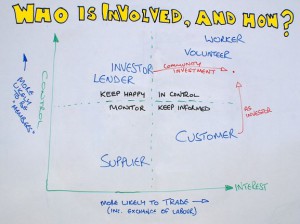

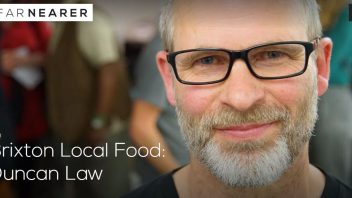
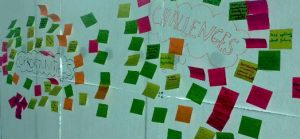

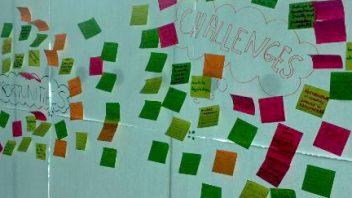
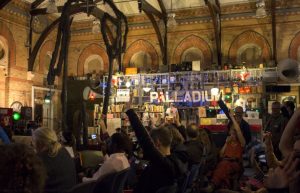

Connect